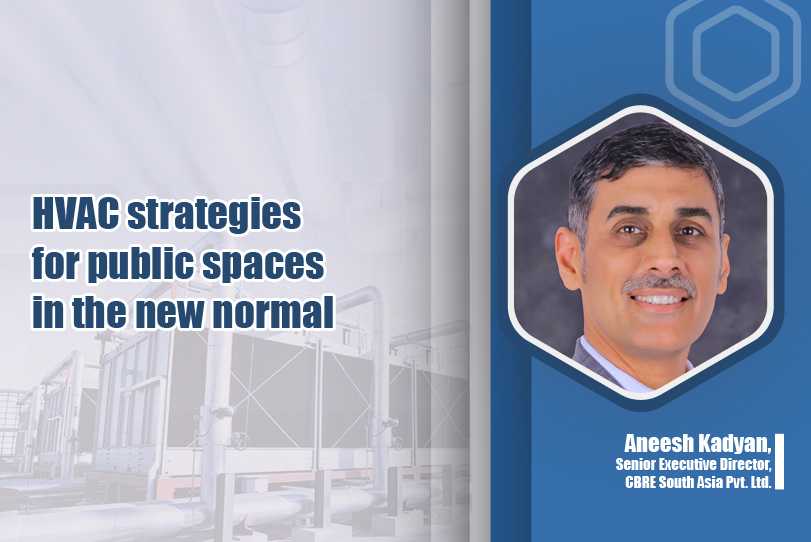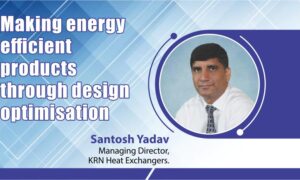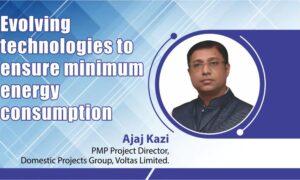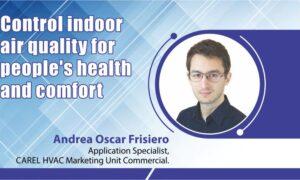Ventilation rates again will have to be studied, because the occupancy might be less.
We all are returning to public spaces. Public spaces essentially mean malls; maybe large eating places or even commercial offices are the common areas. So as we come in, there is always a bit of a worry about whether the place is safe to go to or not. And that is where I think HVAC is going to play a major part. Because ventilation, air, comfort level, and thermal comfort are all going to be important. And that will give confidence to the people who are going to use these public spaces.
So I’m just sharing a bit of a background about what my firm does not from a sales point of view. So we are managing more than 350 million square feet; over 200,000 tonnes of air conditioning is managed by our teams, and there are 300 buildings.
Safety in public places
One is, what should all building owners and people who are managing these public spaces, what should they focus on? Everything is opening up quite a bit. How do you ensure that people are safe out there? So what is the strategy to use? I’m not going to talk about any data point in terms of all the ASHRAE Standards or the different touch points. What about a lot of developers and owners of these public spaces? Because there will be some property managers and some developer teams as well, that might be of interest to them. So first and foremost especially in public spaces, you don’t know how many people are really going to come back.
Occupancy levels increasing post lockdown
Yes, we have seen occupancy increase, but it’s not the way it was in 2019. So we are seeing some places, some good malls, or in buildings as well, the building occupancy is pretty low. But in malls, even 80 percent occupancy is back in some places. So it’s very important for the HVAC and OEM teams to understand what the footfall is. Is it going to ramp up suddenly? Or are you going to see a gradual ramp up in about one or two months time, it’s not easy to predict. But that is one area that the HVAC team and the official maintenance teams will have to look into.
Another aspect is there are different requirements in each city, because of the government guidelines because of the Covid situation in each of the cities. So that again is very important when you’re planning for the return to state public spaces. There is a new normal that we are talking about, but it’s actually something new. So how are we changing our procedures and processes? There will be a lot of changes that the operational maintenance team will have to do. For example, there are guidelines which say that instead of starting the air conditioning systems at eight o’clock, you should start them at six o’clock two hours before or maybe two hours afterwards, so that there’s more circulation of air. Now, you can do it once or twice without having a formal procedure, but if it has to be normal practice throughout, then you have to modify your procedures. So this is the time when you do all those changes in your procedures.
One critical aspect is that the staff who were there, who were running these systems who are maintaining the systems, actually some of them have gone back, some of them found other jobs, because that time the malls or the public spaces were not operational. So, you will have less staff, they may not be trained as well as the people you hire. So, there is that element of getting people ready to operate the system effectively. So that is going to be very critical. And of course, safety is going to be paramount. So of course, basic safety aspects, in terms of operations and maintenance, but more importantly, Covid safety, all the social distancing aspects will have to be done. And then comes the testing of systems.
Backup strategy
Because of the long layoff, and the repeated lockdowns which happened, we have seen that when we restarted buildings, there were some failures in the system. So maybe condenser tubes started leaking; they were leakages from the cooling towers, some pumps didn’t operate effectively. So it’s very important that you run the systems. And of course, a backup plan in case something does fail, then what’s your strategy because in a routine course, people had backup plans, emergency response plans were there. But since there’s a long layoff, what are the revised backup plans, this is something which the teams will have to work on. Now we come to the actual strategy to keep the occupants and people coming into these public spaces. So this could be hospitals, could be airports; this could be malls that I am talking about. It could even be gyms, for example, which are centrally air conditioned.
First and foremost, I think there is a lot of talk about it, natural ventilation, fresh air use, it’s easier said than done, a lot of systems are not designed to cater for the additional fresh air. Some systems, you don’t know how much fresh air is coming in, because you don’t know how they were installed, maybe eight to 10 years back. So, this is one area which the official maintenance team will have to do, ventilation rates again will have to be studied, because the occupancy might be less.
Like I mentioned, operating schedules have to be changed, depending on the number of people who are going to be coming in. What are the timings for those people? All those points will have to be put in. And filtration systems – whatever best filtration system can be provided should be provided. If it means an upgrade, then that definitely should be done to ensure the safety of the people who are coming back.
Filter advantages
There’s one developer we work with, whose entire portfolio is about 35-40 million square feet, they have changed the entire filtration they move from MERV8 to MERV13 across their portfolio, so that that’s the commitment they had for the occupants coming back. Our core job is OEM as well. So there is going to be a need for revising the schedules. Earlier if you are cleaning the filters, maybe once every two weeks, you may have to do it once in a week, depending on the frequency and use. Similarly, maintenance occupants will have to be changed. But the biggest challenge which we have seen is that because there are a lot of new people coming in, there is going to be a need for more supervision of these people. Behaviour will be very important. It’s basically how the people who are coming into the mall, the social distance, and wearing masks and all those things are there.
So this I think is going to be crucial to get people back especially in offices. There’s going to be a strong communication plan which occupiers will have to tell the people who are coming, that when they come back, it is safe, it is hygienic. They have taken care of all the government guidelines, the WHO guidelines, and the people who are coming in the public spaces are not at risk when they come in or at least minimise risk.
Operational strategy
The cost is going to be a major factor I feel, because there is pressure for anybody now and a lot of us I am sure are in the building operation space. The costs have this pressure to reduce costs. But at the same time, you have to change your filters and you have to increase the maintenance frequency. So these are two opposite requirements. And that’s where the OEM team will have to have a good operations strategy to keep the costs minimised and have a balance between the need for higher maintenance and of course, to keep the cost low.
But this is also a good time for occupiers. And people, who are running these systems or doing retrofits of the legacy systems, improve efficiency wherever they can. And while still there are footfalls and the occupancy hasn’t come to full capacity. So, there is still time for people to put that investment in now, because we don’t know how far this pandemic will last. If it goes off, it’s great. But assuming that there is some time still, that is, I think, is one area where the developers can look at investing at this point in time in new technologies, both from the filtration point of view as well as the equipment which are being run. So, in a nutshell, to summarise, I would say that the HVAC is an important factor in giving people the comfort to come back. The option of not having HVAC is not there. And there are ASHRAE as well as WHO studies and guidelines which say that air conditioning and filtration helps introduce the transmission. I think that question has been sorted out quite some time back, and HVAC will help people to come back, just as operations and maintenance teams and as owners of buildings, we have to see that we have a proper strategy to get the systems running and operating effectively.
I conclude with a very, very relevant quote by ‘Mahatma Gandhi that the future depends on what we do today.’ We are all in this together, we have come out and reached the stage very, very effectively. Just we have to maintain a bit more caution, both at a personal level and as an operator and maintainer of HVAC systems to see that we complete this journey.
Cookie Consent
We use cookies to personalize your experience. By continuing to visit this website you agree to our Terms & Conditions, Privacy Policy and Cookie Policy.















